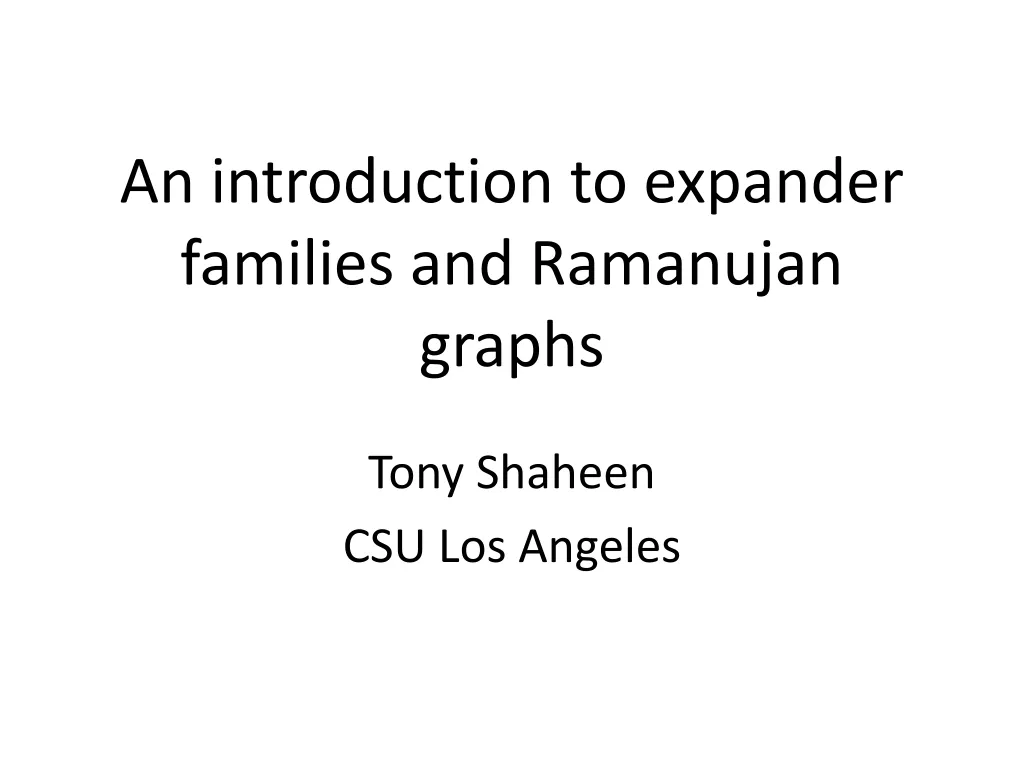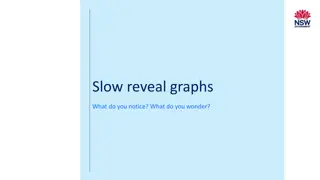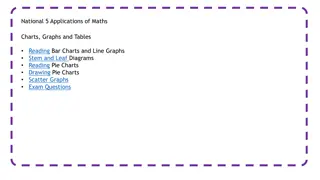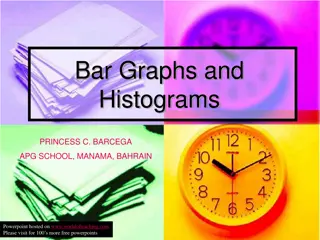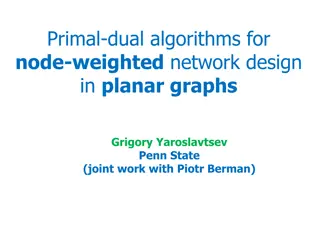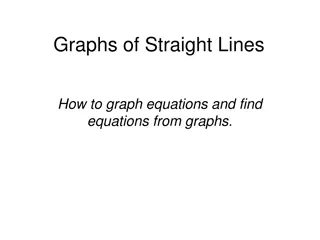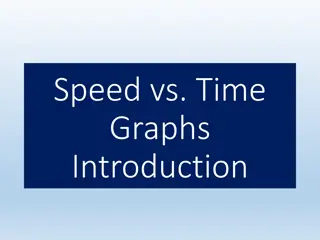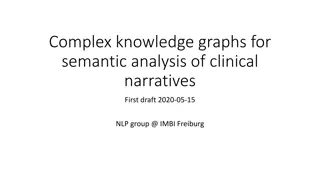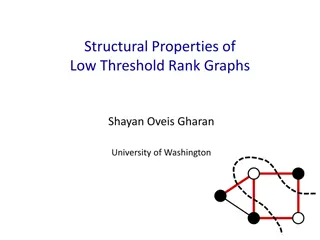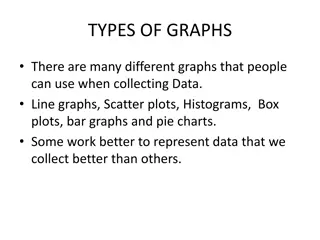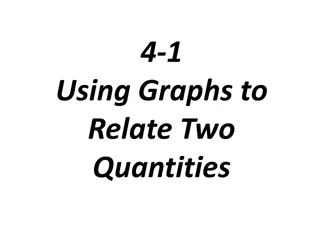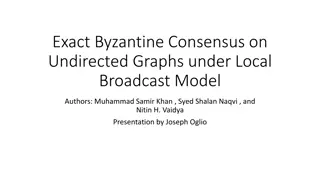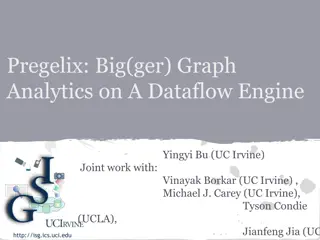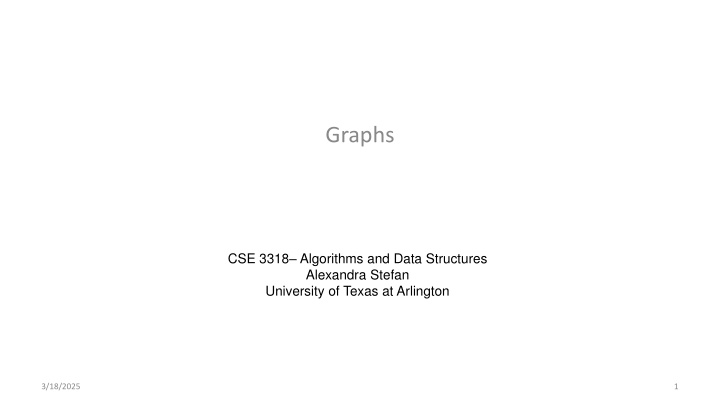
Graphs in Algorithms and Data Structures: Understanding Representations and Concepts
Explore the world of graphs in CSE 3318 course by Alexandra Stefan at the University of Texas at Arlington. Learn about graph definitions, representations, traversal algorithms, and essential concepts like vertices, edges, paths, cycles, and connectivity. Discover the difference between directed and undirected graphs, as well as the significance of degrees in graph theory.
Download Presentation

Please find below an Image/Link to download the presentation.
The content on the website is provided AS IS for your information and personal use only. It may not be sold, licensed, or shared on other websites without obtaining consent from the author. If you encounter any issues during the download, it is possible that the publisher has removed the file from their server.
You are allowed to download the files provided on this website for personal or commercial use, subject to the condition that they are used lawfully. All files are the property of their respective owners.
The content on the website is provided AS IS for your information and personal use only. It may not be sold, licensed, or shared on other websites without obtaining consent from the author.
E N D
Presentation Transcript
Graphs CSE 3318 Algorithms and Data Structures Alexandra Stefan University of Texas at Arlington 3/18/2025 1
References and Recommended Review Recommended Student Review from CSE 2315 Representation Adjacency matrix Adjacency lists Concepts: vertex, edge, path, cycle, connected. Search: Breadth-first Depth-first Recommended: CLRS Graph definition and representations CLRS (3rd edition) - Chapter 22.1 (pg 589) Sedgewick - Ch 3.7 (pg 120) 115-120: 2D arrays and lists Graph traversal CLRS: BFS - 22.2, DFS-22.3 Sedgewick, Ch 5.8 The code used in slides is from Sedgewick. See other links on the Code page. 2
Graphs Graphs are representations of structures, set relations, and states and state-transitions. Direct representation of a real-world structures Networks (roads, computers, social) States and state transitions of a problem. Game-playing algorithms (e.g., Rubik s cube). Problem-solving algorithms (e.g., for automated proofs). For some problems you do not have the entire graph because it is too big. You build it as you go (based on the moves played in the game) 0 6 2 1 A graph is defined as G = (V,E) where: V : set of vertices (or nodes). E : set of edges. Each edge is a pair of two vertices in V: e = (v1,v2). 7 3 5 4 3
Graphs G = (V,E) How many graphs are here?: 1 |V| = 8 , V: { 0, 1, 2, 3, 4, 5, 6, 7 } |E| = 7 , E: { (0,2), (0,6), (0, 7), (3, 4), (3, 5), (4, 5), (6,7)}. Paths Are 2 and 7 connected? Yes: paths 2-0-6-7 or 2-0-7 Are 1 and 3 connected? No. Cycle A path from a node back to itself. Any cycles here? 3-5-4-3, 0-6-7-0 Directed / undirected Connected component (in undirected graphs) A set of vertices s.t. for any two vertices, u and v, there is a path from u to v. Here: Maximal: {1}, {3,4,5}, {2,0,6,7}. Non-maximal {0,6,7}, {3,5}, In directed graphs: strongly connected components. Degree of a vertex Number of edges incident to the vertex (for undirected graphs). Here: degree(0) = 3, degree(1) = 0 , degree(5) = 2 Sparse /dense Representation: adjacency matrix, adjacency list Note: A tree is a graph that is connected and has no cycles undirected graph 0 6 2 1 7 3 5 4 4
Directed vs Undirected Graphs Graphs can be directed or undirected. directedgraph Undirected graph: edges have no direction edge (A, B) means that we can go (on that edge) from bothA to B and B to A. 0 6 2 Directed graph: edges have direction edge (A, B) means that we can go (on that edge) from A to B, but not from B to A. will have both edge (A, B) and edge (B, A) if A and B are linked in both directions. 1 7 3 5 4 Degree of a vertex of a directed graph: - In-degree number of edges arriving at this vertex - Out-degree number of edges leaving from this vertex Vertex 0 4 5 1 7 In degree 5 Out-degree
Directed vs Undirected Graphs Graphs can be directed or undirected. directedgraph Undirected graph: edges have no direction edge (A, B) means that we can go (on that edge) from bothA to B and B to A. 0 6 2 Directed graph: edges have direction edge (A, B) means that we can go (on that edge) from A to B, but not from B to A. will have both edge (A, B) and edge (B, A) if A and B are linked in both directions. 1 7 3 5 4 Degree of a vertex of a directed graph: - In-degree number of edges arriving at this vertex - Out-degree number of edges leaving from this vertex Vertex 0 4 5 1 7 In degree 2 2 0 0 1 6 Out-degree 2 0 2 0 1
Strongly Connected Components (Directed Graphs) Graph How many connected components does this graph have? 1. Can you get from 0 to every other vertex? 2. Can you get from 3 to 6? 0 1 2 3 4 5 6 Strongly connected components: For directed graphs we define strongly connected components: a subset of vertices, Vs, and the edges between them , Es, such that for any two vertices u,v in Vs we can get from u to v (and from v to u) with only edges from Es. Strongly connected components in this graph: {0,1,4,5}, {0,4}, {1,5,4}, {0,5,4} NOT strongly connected components. {6,2,3}, {0,1} Why? 0 1 0 4 5 4 1 0 4 5 4 5 NOT strongly connected 0 1 7
Graph Representations G = (V,E). Let |V| = N and |E| = M. |V| is the size of set V, i.e. number of vertices in the graph. Similar for |E|. Notation abuse: V (and E) instead of |V| (and |E|). Vertices: store N E.g.: If graph G has N=8 vertices, those vertices will be: 0, 1, 2, 3, 4, 5, 6, 7. Excludes case where additional labels are needed for vertices (e.g. city names). Edges: 2 representations: Adjacency matrix: A is a 2D matrix of size VxV Adjacency lists: A is a 1D array of V linked lists 0 1 2 3 4 5 6 7 0 0 1 1 0 0 1 1 1 0 1 2 3 1 1 0 0 0 0 0 0 0 1 0 2 3 2 1 0 0 0 0 0 0 0 3 0 0 0 0 1 1 0 0 2 0 1 4 0 0 0 1 0 1 1 1 3 0 1 5 1 0 0 1 1 0 0 0 6 1 0 0 0 1 0 0 0 7 1 0 0 0 1 0 0 0 8
Adjacency Matrix - Space complexity: (V2) - Time complexity for add/remove/check edge: (1) - Time complexity to find neighbors: (V) V vertices labelled: 0,1, . . . , V-1. Represent edges using a 2D matrix, M, of size V*V. M[x][y] = 1 if and only if there is an edge from x to y. M[x][y] = 0 otherwise (there is no edge from x to y). 0 0 1 2 3 4 5 6 7 6 0 0 1 1 0 0 1 1 1 1 1 0 0 0 0 0 0 0 2 2 1 0 0 0 0 0 0 0 1 3 0 0 0 0 1 1 0 0 7 4 0 0 0 1 0 1 1 1 3 5 1 0 0 1 1 0 0 0 6 1 0 0 0 1 0 0 0 5 4 7 1 0 0 0 1 0 0 0 Note: the adjacency matrix of non-directed graphs is symmetric. 9
typedef struct struct_graph * graphPT; struct struct_graph { int undirected; int V; int ** E; }; graphPT newGraph(int V, int undirected) { graphPT res = malloc(sizeof(struct_graph)); res->undirected = undirected; res->V = V; res->E = alloc_2d(V, V); // the graph contains no edges (also 0 from caloc). for (int i = 0; i < V; i++) for (int j = 0; j < V; j++) res->E[i][j] = 0; return res; } int edgeExists(graphPT g, int x, int y){ // (1) return g->E[x][y]; } void addEdge(graphPT g, int x, int y){ // (1) g->E[x][y] = 1; if (g->undirected ==1) g->E[y][x] = 1; } void removeEdge(graphPT g, int x, int y){ // (1) g->E[x][y] = 0; if (g->undirected ==1) g->E[y][x] = 0; } C implementation for Adjacency Matrix (Undirected graph ) 0 1 2 3 4 5 6 7 0 0 1 1 0 0 1 1 1 1 1 0 0 0 0 0 0 0 2 1 0 0 0 0 0 0 0 3 0 0 0 0 1 1 0 0 4 0 0 0 1 0 1 1 1 5 1 0 0 1 1 0 0 0 6 1 0 0 0 1 0 0 0 7 1 0 0 0 1 0 0 0 void destroyGraph(graphPT g){ if (g == NULL) return; free_2d(g->E, g->V, g->V); free(g); } 10
Dynamic 2D array (allocate and free) // the memory allocated by this function is initialized to 0 int ** alloc_2d(int rows, int columns) { int row; // allocate space to keep a pointer for each row int ** table = (int**)calloc(rows , sizeof(int *)); Draw a picture with the data representation. // VERY IMPORTANT: allocate the space for each row for (row = 0; row < rows; row++) table[row] = (int*)calloc(columns , sizeof(int)); return table; } void free_2d(int ** array, int rows, int columns) { // VERY IMPORTANT: free the space for each row for (int row = 0; row < rows; row++) free(array[row]); // free the space with the pointer to each row. free(array); } 11
Adjacency Lists Represent the edges of the graph by an array of linked lists. Let s name that array A A[x] is a list containing the neighbors of vertex x. 2 5 6 7 1 A 0 0 0 6 1 0 2 2 1 4 5 3 7 3 5 6 7 4 3 5 0 3 4 6 5 0 4 4 7 0 4 12
C implementation of Adjacency Lists typedef struct struct_node * nodePT; struct struct_node{ int data; nodePT next; } // struct_graph*is used to hide the implementation typedef struct struct_graph * graphPT; struct struct_graph{ int undirected; int V; nodePT * E; // array of linked lists }; //Time: (deg(x)), O(V) Space: (1) _ int edgeExists(graphPT g, int x, int y) { for(nodePt n=g->E[x]; n!=NULL; n=n->next) if (n->data == y) return 1; return 0; } //Time: (deg(x)), O(V) Space: (1) _ void addEdge(graphPT g, int x, int y){ if (edgeExists(g, x, y)) return; g->E[x]=insert_sorted(g->E[x], NULL, new_node(y, NULL)); // insert in order if ((x != y) && (g->undirected == 1)) g->E[y]=insert_sorted(g->E[y], NULL, new_node(x, NULL)); //insert in order } // Similar for remove edge: iterate through lists of x and y to find the other and remove it. 1 2 3 6 0 3 4 0 4 0 1 13
Adjacency Lists G(V,E) A 2 3 1 Space for A For nodes: 0 3 2 0 1 0 1 Time to remove an edge? Time to check if an edge exists or not Worst case: Time to add an edge? 14
Adjacency Lists G(V,E) A 2 3 1 Space: (E + V) For A: (V) For nodes: (E) If the graph is relatively sparse, E << V2, this can be a significant advantage. 0 3 2 0 1 0 1 Time to check if an edge exists or not: O(V) Worst case: (V). Each vertex can have up to V-1 neighbors, and we may need to go through all of them to see if an edge exists. Slower than using adjacency matrices. Time to remove an edge: O(V) If must check if the edge exists. Time to add an edge: O(V) If must check if the edge exists. Why? Because if the edge already exists, we should not duplicate it. 15
Check Out Posted Code graph.h: defines an abstract interface for basic graph functions. graph_matrix.c: implements the abstract interface of graph.h, using an adjacency matrix. See also: twoD_arrays.h, twoD_arrays.c for a 2D matrix implemention. graph_list.c: also implements the abstract interface of graph.h, using adjacency lists. graph_main: a test program, that can be compiled with either graph_matrix.c or graphs_list.c. 16
Sparse Graphs 1 If G(V,E) , max possible edges. Directed: (V2) Exact: V*(V-1) Undirected : (V2) Exact: [V*(V-1)]/2 Sparse graph 0 2 4 3 A graph with E << V2 (E much smaller than V2 ). https://www.google.com/search?q=image+sparse+graph&tbm=isch&source=univ&sa=X&ved=2ahUKEwi WnLzYpubhAhVSPawKHQ0IDq8QsAR6BAgJEAE&biw=800&bih=528&dpr=2#imgrc=-4yhnsETTHLWcM: E.g. consider an undirected graph with 106 nodes Number of edges if 20 edges per node: 106*20/2 Max possible edges 106*(106-1)/2 => 105 factor between max possible and actual number of edges => Use adjacency lists Can you think of real-world data that may be represented as sparse graphs? 17
Student self study: Space Analysis: Adjacency Matrices vs. Adjacency Lists Suppose we have an undirected graph with: 10 million vertices. Each vertex has at most 20 neighbors. Individual practice: Calculate the minimum space needed to store this graph in each representation. Use/assume: A matrix of BITS for the matrix representation An int is stored on 8 bytes and a memory address is stored on 8 bytes as well. Calculate the space requirement (actual number, not ) for each representation. Compare your result with the numbers below. Check your solution against the posted one. Clarify next lecture any questions you may have. Adjacency matrices: we need at least 100 trillion bits of memory, so at least 12.5TB of memory. Adjacency lists: in total, they would store at most 200 million nodes. With 16 bytes per node (as an example), this takes at most 3.28 Gigabytes. We ll see next how to compute/verify such answers. 18
Steps for Solving This Problem: understand all terms and numbers Suppose we have an undirected graph with: 10 million vertices. Each vertex has at most 20 neighbors. Adjacency matrices: we need at least 100 trillion bits of memory, so at least 12.5TB of memory. Adjacency lists: in total, they would store at most 100 million nodes. With 16 bytes per node (as an example), this takes 3.28 Gigabytes. Find keywords , understand numbers: 10 million vertices => 10 * 106 Trillion = 1012 1 TB (terra bytes) = 1012 bytes 1GB = 109 bytes 100 Trillion bits vs 12.5 TB (terra bytes) 19
Solving: Adjacency Matrix Suppose we have a graph with: 10 million vertices. => V = 10*106 =107 Each vertex has at most 20 neighbors. Adjacency matrix representation for the graph: The smallest possible matrix: a 2D array of bits => The matrix size will be: V x V x 1bit => 107 * 107 * 1bit = 1014 bits Bits => bytes: 1byte = 8bits => 1014bits = 1014/8 bytes = 100/8*1012bytes = 12.5*1012bytes 12.5*1012bytes = 12.5 TB (final result) 1012bytes = 1TB 20
Solving: Adjacency List Suppose we have an undirected graph with: 10 million vertices. => V = 107 Each vertex has at most 20 neighbors. Adjacency lists representation of graphs: For each vertex, keep a list of edges (a list of neighboring vertices) Space for the adjacency list array: = 10 million vertices*8 bytes (memory address) = 8*107 bytes = 0.08 GB Space for all the nodes (from the list for each vertex): 107vertices * (20 neighbors/vertex) = 20*107 nodes = 2*108 nodes Assume 16 bytes per node: 8 bytes for the next pointer, and 8 bytes for the data (vertex): 2*108 nodes * 16byte/node = 32 * 108 bytes = 3.2 * 109 bytes = 3.2GB Total: 3.2GB + 0.08 GB = 3.28GB ( 109 bytes = 1GB (GigaByte) ) 21
Graph Traversal / Graph Search We will use "graph traversal" and "graph search" almost interchangeably. However, there is a small difference: "Traversal": visit every node in the graph. "Search": visit nodes until find what we are looking for. E.g.: A node labeled "New York". A node containing integer 2014. Graph traversal: Input: start/source vertex. Output: a sequence of nodes resulting from graph traversal. 0 6 2 1 7 3 5 4 22
Graph Traversals Breath-First Search (BFS) - call: BFS(G,s) - O(V+E) (when Adj list repr) - Explores vertices in the order: root, (white) (Here root = starting vertex, s) vertices 1 edge away from the root, (yellow) vertices 2 edges away from the root, (orange) and so on until all nodes are visited - If graph is a tree, gives a level-order traversal. - Finds shortest paths from a source vertex. *Length of the path is the number of edges on it. E.g. Flight route with fewest connections. Depth-First Search (DFS) - call: DFS(G) - O(V+E) (when Adj list repr) - Explores the vertices by following down a path as much as possible, backtracking and continuing from the last discovered node. - Useful for Finding and labelling connected components (easy to implement) Finding cycles Topological sorting of DAGs (Directed Acyclic Graphs). 0 1 2 3 0 1 2 3 7 4 5 6 7 4 5 6 Below, nodes traversed in order: 0, 1,4,5, 6,7, 2,3 0 1 2 3 0 1 2 3 7 4 5 6 7 4 5 6 23 For both DFS and BFS the resulting trees depend on the order in which neighbors are visited.
Vertex coloring while searching Vertices will be in one of 3 states while searching and we will assign a color for each state: White undiscovered Gray discovered, but the algorithm is not done processing it Black discovered and the algorithm finished processing it. 24
Space complexity: O(V) Breadth-First Search (BFS) CLRS 22.2 Time complexity: Representation BFS time complexity Adj LIST O(V+E) O(V2) BFS-Visit(G,s) // search graph G starting from vertex s. 1. For each vertex u of G 1. color[u] = WHITE // undiscovered 2. dist[u] = inf // distance from s to u 3. pred[u] = NIL // predecessor of u on the path from s to u 2. color[s] = GRAY // s is being processed 3. dist[s] = 0 4. pred[s] = NIL 5. Initialize empty queue Q 6. put(Q,s) // s goes to the end of Q 7. While Q is not empty 1. u = get(Q) // removes u from the front of Q 2. For each y adjacent to u //explore edge (u,y) // in increasing order 1. If color[y] == WHITE 1. color[y] = GRAY 2. dist[y] = dist[u]+1 3. pred[y] = u 4. put(Q,y) 3. color[u] = BLACK Adj MATRIX Vertex Edge Distance s Queue, Q: 0 1 3 2 4 5 6 Aggregatetime analysis: for each vertex, for each edge => 2*E=>O(E)
Breadth-First Search (BFS) CLRS 22.2 Solution to do BFS-Visit(G,s) // search graph G starting from vertex s. 1. For each vertex u of G 1. color[u] = WHITE // undiscovered 2. dist[u] = inf // distance from s to u 3. pred[u] = NIL // predecessor of u on the path from s to u 2. color[s] = GRAY // s is being processed 3. dist[s] = 0 4. pred[s] = NIL 5. Initialize empty queue Q 6. put(Q,s) // s goes to the end of Q 7. While Q is not empty 1. u = get(Q) // removes u from the front of Q 2. For each y adjacent to u //explore edge (u,y) // in increasing order 1. If color[y] == WHITE 1. color[y] = GRAY 2. dist[y] = dist[u]+1 3. pred[y] = u 4. put(Q,y) 3. color[u] = BLACK Space complexity: O(V) Time complexity: Representation BFS time complexity Adj LIST O(V+E) O(V2) Adj MATRIX Vertex Edge Distance s Queue, Q: 0 1 3 2 4 5 6 Aggregatetime analysis: for each vertex, for each edge => 2*E=>O(E)
Breadth-First Search (BFS): Note that the code above, CLRS22.2 algorithm, assumes that you will only call BFS(G,s) once for s, and not attempt to find other connected components by calling it again for unvisited nodes. If the graph is NOT connected, you will not reach all vertices when starting from s => time complexity is O, not . (I have seen variation where they restart BFS from the first unvisited node, like DFS) 27
Space complexity: O(V) Depth-First Search (DFS) simple version Time complexity: Representation DFS DFS-Visit(G,u) Adj LIST (V+E) (neighbors of u) (V2) Adj MATRIX (V) DFS(G) 1. Visited vertex Pred For each vertex u of G a. color[u] = WHITE b. pred[u] = NIL for (u = 0; u<G.V; u++) // for each vertex u of G a. If color[u] == WHITE 1. DFS_visit(G, u, color, pred) 2. DFS_visit(G,u,color, pred) 1. color[u] = GRAY 2. For each y adjacent to u // explore edge (u,y) // use increasing order for neighbors a. If color[y]==WHITE 1. pred[y] = u 2. DFS_visit(G,y, color, pred) b. //if color[y]==GRAY then cycle found 3. color[u] = BLACK List: __ / __ __ / __ __ / __ __ / __ 4 6 2 1 3 5 0 28 __ / __ __ / __ __ / __
Edge Classification: tree, backward, C/F Arrow color (my convention) Edge type for (u,v) Color of v Comments Tree White v is first discovered Backward Gray There is a cycle C/F (Forward) Black Shortcut. v is a descendant of u v started after u started v started and finished BEFORE u started C/F (Cross) Black v is not a descendant of u v started before u started v started and finished AFTER u started We will use the labels: tree, backward, C/F and not care if C/F is a forward or a cross. The edge classification depends on the order in which vertices are discovered, which depends on the order by which neighbors are visited. 4 6 2 1 4 6 2 1 3 5 0 3 5 0 DFS(G,0): 0, 1, 2, 5, 3, 4, 6 Visit neighbors in increasing order. DFS(G,0): 0, 2, 1, 5, 3, 6, 4 Visit neighbors of 3 in order: 6 and then 4 29
Edge Classification for Undirected Graphs An undirected graph will only have: Tree edges Back edges 30
Topological Sorting Topological sort of a directed acyclic graph (DAG), G, is a linear ordering of its vertices s.t. if (u,v) is an edge in G, then u will be listed before v (all edges point from left to right). If a graph has a cycle, it CANNOT have a topological sorting. Application: 1. Identify strongly connected components in directed graphs. 2. Task ordering (e.g. for an assembly line) Vertices represent tasks Edge (u,v) indicates that task u must finish before task v starts. Topological sorting gives a feasible order for completing the tasks. 0 1 2 3 4 5 6 Give TC for each version. Assume list, L, is an ArrayList in Java. Algorithm version 1 (Alexandra) 1. Initialize an array, res 2. Run DFS - If cycle found, quit => NO topological order - Every time a vertex finishes, add it in res at next position. 3. Reverse the array res and return it. (It will have the vertices listed in decreasing order of DFS finish time). Algorithm version 2 (CLRS): 1. Initialize an empty list L. 2. Call DFS(G) with modification: When a vertex finishes (black) add it at the beginning of list L. NOTE: If a cycle is detected (backward edge), return null. => No topological order. 3. Return L 31
Directed Acyclic Graphs (DAG) & Detecting Cycles in a Graph A graph has a cycle if a DFS traversal finds a backward edge (an edge that points to a gray node). Applies to both directed and undirected graphs. A Directed Acyclic Graph (DAG) is a directed graph that has no cycles. 0 1 2 3 4 5 6 32
Topological Sorting - Worksheet There may be more than one topological order for a DAG. In that case, any one of those is good. Red arrows show what is different from the graph in Example 1. Example 1 Example 2 (from previous page) 0 1 2 3 0 1 2 3 4 5 6 4 5 6 Topological order: Topological order: Example 3 0 1 2 3 4 5 6 33 Topological order:
Topological Sorting - Answer There may be more than one topological order for a DAG. In that case, any one of those is good. Red arrows show what is different from the graph in Example 1. Example 1 Example 2 0 1 2 3 0 1 2 3 4 5 6 4 5 6 Topological order: 4, 0, 1, 5, 6, 2, 3 ( 0, 4, 1, 5, 6, 2, 3 ) Topological order: 6, 4, 2, 3, 0, 1, 5 ( 0, 4, 1, 6, 2, 3, 5 ) ( 0, 4, 1, 6, 2, 5, 3 ) Example 3 Simple pseudocode: Run DFS and return time finish time data. - If cycle found, quit => NO topological order Return array with vertices in reversed order of finish time. 0 1 2 3 4 5 6 34 Topological order: none. It has a cycle.
Strongly Connected Components in a Directed Graph Strongly_Connected_Components(G) 1. finish1= DFS(G) //Call DFS and return the vertex finish time, finish1 2. Compute GT 3. Call DFS(GT), but in its main loop consider the vertices in order of decreasing finish time,finish1, (i.e. in topological order). 4. Output the vertices of each tree from line 3 as a separate strongly connected component. Visited vertex Pred Finish Where: GT = (V, ET) , with ET= {(y,x) : (x,y) E} - the transpose of G: a graph with the same vertices as G, but with edges in reverse order. Finished (reverse order): (Every node that finishes is added at the front) Consider different list implementations (array/linked list), and the time complexity for them. Can you use a regular array of size N? Can you add every node that finishes at the END? / / / / / / / / 4 6 2 1 4 6 2 1 3 5 0 3 5 0 35 / / / / / /
Applications of Strongly Connected Components (SCC) Simplify graph: collapse every SCC in one node From stackoverflow (https://stackoverflow.com/questions/11212676/what-are-strongly-connected-components-used-for) Model checking - model checking is applied widely in the industry - especially for proving correctness of hardware components. Vehicle routing applications A road network can be modeled as a directed graph, with vertices being intersections, and arcs being directed road segments or individual lanes. If the graph isn't Strongly Connected, then vehicles can get trapped in a certain part of the graph (i.e. they can get in, but not get out). From Wikipedia (https://en.wikipedia.org/wiki/Strongly_connected_component) SCC may be used to solve 2-satisfiability problems (systems of Boolean variables with constraints on the values of pairs of variables) From neo4j (https://neo4j.com/docs/graph-algorithms/current/labs-algorithms/strongly-connected-components/) In the analysis of powerful transnational corporations, SCC can be used to find the set of firms in which every member owns directly and/or indirectly owns shares in every other member. Although it has benefits, such as reducing transaction costs and increasing trust, this type of structure can weaken market competition. SCC can be used to compute the connectivity of different network configurations when measuring routing performance in multi hop wireless networks applications in cell methods for the numerical study of discrete dynamical systems https://math.stackexchange.com/questions/32041/uses-of-strongly-connected-components 36
Directed Graphs Adjacency Matrix - Worksheet directedgraph Fill in the matrix representation. Use row as source and column as destination for edges. Update it for each edge: (0,2), (0,6), (3,4) (7,0) 0 6 2 1 7 3 5 4 Degree of a vertex of a directed graph: - In-degree number of edges arriving at this vertex - Out-degree number of edges leaving from this vertex Vertex 0 4 5 1 7 In degree Out-degree 37
Directed Graphs Adjacency List - Worksheet directedgraph Give the Adjacency list representation. Size __ array of _____________ (type of data in array) Update it for each edge: (0,2), (0,6), (3,4) (7,1) 0 6 2 1 7 3 5 4 Degree of a vertex of a directed graph: - In-degree number of edges arriving at this vertex - Out-degree number of edges leaving from this vertex Vertex 0 4 5 1 7 In degree Out-degree 38
Extra Slides 39
C implementation for Adjacency Matrix Undirected graph Simple version where the graph is represented by only N and E. void graphCreateAndWork() { int N; scanf("%d",&N); int E[N][N]; for (int i = 0; i < N; i++) for (int j = 0; j < N; j++) E[i][j] = 0; // call graph function here, e.g.: // addEdge(N,E,1,3); } int edgeExists(int N, int E[][N], int v1, int v2){ if (v1>=N || v1<0 || v2>=N || v2<0) return -1; return E[v1][v2]; } void addEdge(int N, int E[][N], int v1, int v2){ if (v1>=N || v1<0 || v2>=N || v2<0) return; E[v1][v2] = 1; E[v2][v1] = 1; } void removeEdge(int N, int E[][N], int v1, int v2){ if (v1>=N || v1<0 || v2>=N || v2<0) return; E[v1][v2] = 0; E[v2][v1] = 0; } 0 1 2 3 4 5 6 7 0 0 1 1 0 0 1 1 1 1 1 0 0 0 0 0 0 0 2 1 0 0 0 0 0 0 0 3 0 0 0 0 1 1 0 0 4 0 0 0 1 0 1 1 1 5 1 0 0 1 1 0 0 0 6 1 0 0 0 1 0 0 0 7 1 0 0 0 1 0 0 0 Remember that you cannot return, from a function, an array allocated on the stack (with [][]) . Function graphCreateAndWork must NOT return E. 40
DFS with time stamps Next, DFS with time stamps of when a node u was first discovered (d[u]) and the time when the algorithm finished processing that node (finish[u]). The time stamps are needed for: Topological sorting Finding strongly connected components edge labeling (to distinguish between forward and cross edges) tree edge backward edge forward edge cross edge The following pseudo-code does not specify all the details of the implementation 41
Depth-First Search (DFS) (with time stamps) - CLRS Node u will be: - WHITE before time d[u], - GRAY between d[u] and finish[u], - BLACK after finish[u] WHITE GRAY DFS(G) 1. When coding you can use any convention to represent the colors: strings, chars(w/b/g), int (0,1,2), etc. For each vertex u of G 1. color[u] = WHITE 2. pred[u] = NIL 3. d[u] = -1 4. finish[u] = -1 time = 0 For (u=0;u<G.N;u++) //each vertex u of G 1. If color[u] == WHITE // u is in undiscovered 1. DFS_visit(G, u ,&time, color, pred, d, finish) BLACK d[u] finish[u] Time complexity: In the graph picture below, assume no answer means the initial values: NIL, -1,-1 Representation DFS DFS-Visit(G,u) Adj LIST (|V|+|E|) (neighbors of u) 2. 3. (|V|2) Adj MATRIX (|V|) Visited vertex Pred Start Finish Space complexity: O(V) // Search graph G starting from vertex u. u must be WHITE DFS_visit(G,int u, int* time, ColType*color, int* pred, int* d, int* finish) 1. (*time) = (*time) + 1 2. d[u] = time// time when u was discovered 3. color[u] = GRAY 4. For each v adjacent to u // assume increasing order 1. If color[v]==WHITE // if color[v]==GRAY=>cycle found 1. pred[v] = u 2. DFS_visit(G,v, ..) 5. color[u] = BLACK 6. (*time) = (*time) + 1//no two time stamps are equal. 7. finish[u] = time (See CLRS page 605 for step-by-step example.) Discover time Finish time pred __ / __ / __ __ / __ / __ __ / __ / __ __ / __ / __ 4 6 2 1 3 5 0 __ / __ / __ 42 __ / __ / __ __ / __ / __
Worksheet Convention: start /end pred Run DFS on the graphs below. Visit neighbors of u in increasing order. For each node, write the start and finish times and the predecessor. Do edge classification as well. Order from 1st to last Visited vertex Pred Start Finish __ / __ / __ __ / __ / __ __ / __ / __ __ / __ / __ 0 1 8 3 6 __ / __ / __ 4 5 7 2 __ / __ / __ __ / __ / __ __ / __ / __ __ / __ / __ 43 DFS(G): DFS(G) (note that 0 moved)
Edge Classification Arrow color (my convention) Edge type for (u,v) Color of v Comments Tree White v is first discovered Backward Gray There is a cycle Forward Black Shortcut. v is a descendant of u v started after u started v started and finished BEFORE u started Cross Black v is not a descendant of u v started before u started v started and finished AFTER u started The edge classification depends on the order in which vertices are discovered, which depends on the order by which neighbors are visited. 4 6 2 1 4 6 2 1 3 5 0 3 5 0 DFS(G,0): 0, 1, 2, 5, 3, 4, 6 Visit neighbors in increasing order. DFS(G,0): 0, 2, 1, 5, 3, 6, 4 Visit neighbors of 3 in order: 6 and then 4 44
Edge Classification for Undirected Graphs An undirected graph will only have: Tree edges Back edges As there is no direction on the edges (can go both ways), what could be a forward or a cross edge will already have been explored in the other direction, as either a backward or a tree edge. Forward (u,v) => backward (v,u) Cross (u,v) => tree (v,u) 45
Strongly Connected Components in a Directed Graph Strongly_Connected_Components(G) 1. finish1= DFS(G) //Call DFS and return the vertex finish time, finish1 2. Compute GT 3. Call DFS(GT), but in its main loop consider the vertices in order of decreasing finish time,finish1, (i.e. in topological order). 4. Output the vertices of each tree from line 3 as a separate strongly connected component. Visited vertex Pred Start Finish Where: GT = (V, ET) , with ET= {(v,u) : (u,v) E} - the transpose of G: a graph with the same vertices as G, but with edges in reverse order. __ / __ / __ __ / __ / __ __ / __ / __ __ / __ / __ __ / __ / __ __ / __ / __ __ / __ / __ __ / __ / __ 4 6 2 1 4 6 2 1 3 5 0 3 5 0 46 __ / __ / __ __ / __ / __ __ / __ / __ __ / __ / __ __ / __ / __ __ / __ / __
Strongly Connected Components in a Directed Graph Worksheet 2 Strongly_Connected_Components(G) 1. finish1= DFS(G) 2. Compute GT 3. Call DFS(GT), but in its main loop consider the vertices in order of decreasing finish time (finish1) 4. Output the vertices of each tree from line 3 as a separate strongly connected component. Visited vertex Start Finish Pred Where: GT = (V, ET) , with ET= {(v,u) : (u,v) E} - the transpose of G: a graph with the same vertices as G, but with edges in reverse order. __ /___ ___ /___ ___ /___ ___ /___ __ /___ ___ /___ ___ /___ ___ /___ 6 1 2 3 6 1 2 3 4 5 0 4 5 0 47 ___ /___ ___ /___ ___ /___ ___ /___ ___ /___ ___ /___
Graph Traversal - Practice BFS : 0 1 2 3 0 1 2 3 7 4 5 6 7 4 5 6 DFS : 0 1 2 3 0 1 2 3 7 4 5 6 7 4 5 6 48
Graph Traversal For both DFS and BFS the resulting trees depend on the order in which neighbors are visited. BFS traversal examples: 0 1 2 3 0 1 2 3 7 4 5 6 7 4 5 6 DFS traversal examples. 0 1 2 3 0 1 2 3 7 4 5 6 7 4 5 6 49
DFS Practice Try various directions for arrows. 0 1 2 3 50 4 5 6

